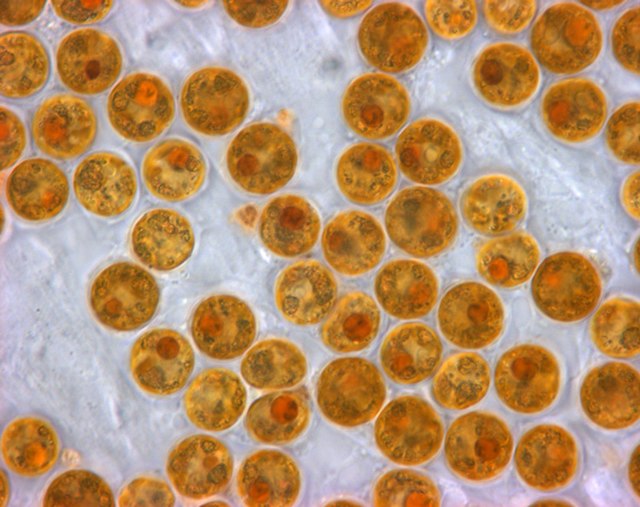Zooxanthellae is a colloquial term for single-celled dinoflagellates that are able to live in symbiosis with diverse marine invertebrates including demosponges, corals, jellyfish, and nudibranchs. Most known zooxanthellae are in the genus Symbiodinium, but some are known from the genus Amphidinium, and other taxa, as yet unidentified, may have similar endosymbiont affinities. The true Zooxanthella K.brandt is a mutualist of the radiolarian Collozoum inerme and systematically placed in Peridiniales. Another group of unicellular eukaryotes that partake in similar endosymbiotic relationships in both marine and freshwater habitats are green algae zoochlorellae.
Yellow-brown zooxanthellae
Cross section of the mantle tissue of a giant clam showing the symbiotic protozoa
A ciliate with green zoochlorellae living inside it endosymbiotically
The dinoflagellates are a monophyletic group of single-celled eukaryotes constituting the phylum Dinoflagellata and are usually considered protists. Dinoflagellates are mostly marine plankton, but they also are common in freshwater habitats. Their populations vary with sea surface temperature, salinity, and depth. Many dinoflagellates are photosynthetic, but a large fraction of these are in fact mixotrophic, combining photosynthesis with ingestion of prey.
Dinoflagellate
Longitudinal (l.f.) and transverse flagellum (t.f.); sack pusule (s.p.); nucleus (n).
1. Ornithocercus; 2. diagram; 3. Exuviaella; 4. Prorocentrum; 5, 6. Ceratium; 7. Warnowia; 8. Citharistes; 9. Polykrikos
Dinophytic microalga isolated from sediments of Amur Bay







